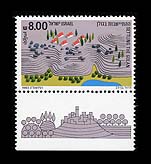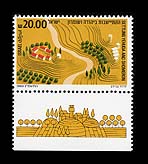|
|
Rural settlement in the land of Israel is one of the basic principles of Zionism. National revival and a sound economy are inseparable from the political independence of the Jewish State, and for this reason an all-out effort has been made to set up country-wide communities with the following aims in view:
1. To establish communities in areas vital to security.
2. To augment Jewish presence in sparsely populated locations.
3. To develop a framework for living which will encourage a healthy outlook and ans awareness of national ideals.
4. Through this framework to absorb and integrate immigrants.
5. To improve agricultural and industrial production for local use and for export.
Two bodies are involved in the movement - the Jewish Agency, which provides full support for settlements within the Green Line (Israel's pre-1967 boundary) and the Zionist Organization, which includes a division for placement outside the Green Line, financed by the State. This was the result of a post-1948 agreement between the Jewish Agency, the Zionist Federation and the State of Israel.
The history of such settlements began in 1870 with the Miqveh Israel Agricultural School, then in 1878 Petah Tiqwa was established to be followed in 1882 by the founding of Rosh Pinna, Rishon Leziyyon, Zikhron Yaaqov, Yesud Ha-maala, Nes Ziyona and Eqron. In 1884 came the BILU - mainly Russian intellectuals, who suffered from lack of farming experience and ignorance of both local conditions and of their Arab neighbours. Baron Edmond de Rothschild came wholeheartedly to their assistance, supporting many of the early villages. In fact, at the First Zionist Congress in 1897, nineteen communities comprising 5000 souls were already in existence.
In 1901 the Zionist Organization came up with a comprehensive plan of action, while certain ideological concepts were also worked out. A kibbutz, for example, was formulated as being a collective where all property was communally owned and all functions communally carried out.
Deganya, the first Kibbutz, was established in 1909 and the second, Kinneret, in 1921, while the Moshav is an alternative, encouraging private living. It may be a Moshav Ovdim, where members have their own homesteads but marketing, care of larger units like factories, orchards and fishponds are run collectively, or it may be a Moshav Shitufi, initiated in 1936. Here, although buying and selling are co-operative, each member receives money to conduct his own household affairs. Parallel to the emergence of these patterns of living, came another - conglomerations of small settlements in outlying areas of strategic importance. Emeq Hefer, Emeq Yisrael, Bet Shean and the Negev are typical examples.
During the British Mandate, especially during the 1936-1939 riots, efforts were made to neutralize Arab enmity and British opposition by the 'Watchtower and Stockade" campaign, when 11 8 villages were erected in Arab centres of population like Upper Galilee and the Bet Shean Valley. After World War 2, in anticipation of statehood, eleven settlements arose in the Negev, enabling the Israelis to defeat the Egyptians in 1 948.
The flood of immigrants after 1948 necessitated housing, employment and immediate food production. Over 300 agricultural settlements were begun by 1953, but the newcomers were town-dwellers, and some sought a more urbanized solution - the Lachish regional plan - which proposed village units radiating from a central town with factories and all facilities. So successful was this project that it was copied in Africa, Asia and Latin America.
A new era was initiated by the Six-Day War. Wide spaces had to be quickly settled; the vastly expanded borders had to be guarded, and Israel had to absorb another type of immigrant - often trained in advanced technology and in search of an improved quality of life. Villages sprang up everywhere, from the Golan Heights to Sinai, peopled with hard-working citizens bound by a common ideal.
Settlement was essential, partly for security, partly to control tracts of unutilized state land, and partly to prevent encroachment by Arabs on the limited arable land available, and settlements went up everywhere - in the Besor region; in the Golan and Galilee; in Judea and Samaria and in the western Negev. There was no lack of applicants the limiting factor was finance, not people, who came from abroad, from veteran kibbutzim and from the towns. Most belong to the moshav shitufi movement, based partially on agriculture but where industry, tourism and services play a major role.
A bird's-eye view of rural development provides a remarkable picture of vision and fulfilment. As early as 1897, at the time of the first Zionist Congress, there were 5000 pioneers living in 19 villages. By the end of the British Mandate in 1948, nearly 300 settlements were in existence, including 118 put up in the "Watchtower and Stockade" era. Mass immigration after 1948 generated the establishment of another 300, then following the Six-Day War, 79 were founded in a ten-year period.
Various factors brought about a tremendous expansion in the past five years. From 1977 until today, about 200 new sites have been settled, including 33 "Mitzpim", or hilltop colonies in the Galilean Highlands, bringing the number of rural settlements in Israel to the extraordinary total of close to 900.



